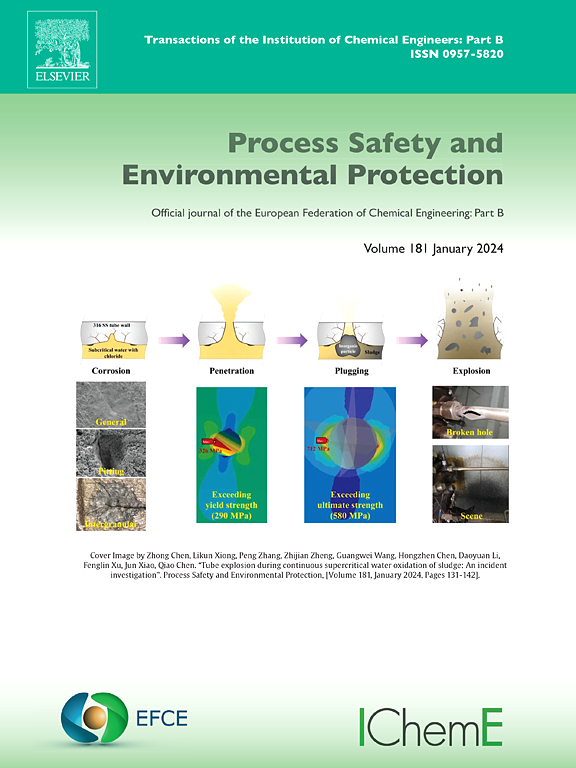加蒂胶作为新型抑制剂对滑石中黄铜矿的选择性浮选分离
IF 7.8
2区 环境科学与生态学
Q1 ENGINEERING, CHEMICAL
引用次数: 0
摘要
黄铜矿与滑石的共生现象使得寻找一种环保高效的抑制剂对实现有效分离至关重要。在本研究中,我们创新地使用了加蒂胶作为滑石抑制剂来改善浮选分离。微浮选试验结果表明,与常规抑制剂相比,gatti Gum对滑石具有更强的抑制作用,同时对黄铜矿保持了良好的选择性。原子力显微镜(AFM)、能量色散x射线能谱扫描电镜(SEM-EDS)和透射电子显微镜(TEM)图像证实,Ghatti Gum选择性吸附在滑石表面,显著改变了滑石表面粗糙度和元素组成。相反,Ghatti Gum对黄铜矿的影响较弱。通过Zeta电位、傅里叶变换红外光谱(FTIR)、x射线光电子能谱(XPS)和密度泛函理论(DFT)计算进一步分析表明,Ghatti Gum通过氢键和疏水相互作用吸附在滑石表面。同时,Ghatti Gum对黄铜矿表面元素组成和可浮性的影响较小。综上所述,Ghatti Gum是一种很有前途的环保型黄铜矿与滑石浮选分离抑制剂。这一发现不仅扩大了Ghatti胶的应用范围,而且为从滑石中高效分离黄铜矿提供了新的见解。本文章由计算机程序翻译,如有差异,请以英文原文为准。
Selective flotation separation of chalcopyrite from talc using Ghatti Gum as a novel depressant
The intergrowth phenomenon of chalcopyrite and talc makes the identification of an eco-friendly and efficient depressant crucial for achieving effective separation. In this study, we innovatively employed Ghatti Gum as a talc depressant to improve the flotation separation. The micro-flotation test results demonstrate that, compared to conventional depressants, Ghatti Gum exhibits a stronger depressing effect on talc while maintaining excellent selectivity toward chalcopyrite. Atomic force microscopy (AFM), scanning electron microscopy with energy-dispersive X-ray spectroscopy (SEM-EDS), and transmission electron microscopy (TEM) images confirmed that Ghatti Gum adsorbed selectively on the surface of talc, which significantly altered its surface roughness and elemental composition. In contrast, Ghatti Gum exerts a weaker influence on chalcopyrite. Further analysis through Zeta potential, Fourier transform infrared spectroscopy (FTIR), X-ray photoelectron spectroscopy (XPS), and density functional theory (DFT) calculations revealed that Ghatti Gum adsorbs onto the talc surface through hydrogen bonds and hydrophobic interactions. Meanwhile, Ghatti Gum has less influence on the elemental composition and floatability of the chalcopyrite surface. In summary, Ghatti Gum emerges as a promising eco-friendly depressant for the flotation separation of chalcopyrite and talc. This discovery not only expands the applications of Ghatti Gum but also provides novel insights for the efficient separation of chalcopyrite from talc.
求助全文
通过发布文献求助,成功后即可免费获取论文全文。
去求助
来源期刊

Process Safety and Environmental Protection
环境科学-工程:化工
CiteScore
11.40
自引率
15.40%
发文量
929
审稿时长
8.0 months
期刊介绍:
The Process Safety and Environmental Protection (PSEP) journal is a leading international publication that focuses on the publication of high-quality, original research papers in the field of engineering, specifically those related to the safety of industrial processes and environmental protection. The journal encourages submissions that present new developments in safety and environmental aspects, particularly those that show how research findings can be applied in process engineering design and practice.
PSEP is particularly interested in research that brings fresh perspectives to established engineering principles, identifies unsolved problems, or suggests directions for future research. The journal also values contributions that push the boundaries of traditional engineering and welcomes multidisciplinary papers.
PSEP's articles are abstracted and indexed by a range of databases and services, which helps to ensure that the journal's research is accessible and recognized in the academic and professional communities. These databases include ANTE, Chemical Abstracts, Chemical Hazards in Industry, Current Contents, Elsevier Engineering Information database, Pascal Francis, Web of Science, Scopus, Engineering Information Database EnCompass LIT (Elsevier), and INSPEC. This wide coverage facilitates the dissemination of the journal's content to a global audience interested in process safety and environmental engineering.
 求助内容:
求助内容: 应助结果提醒方式:
应助结果提醒方式:


